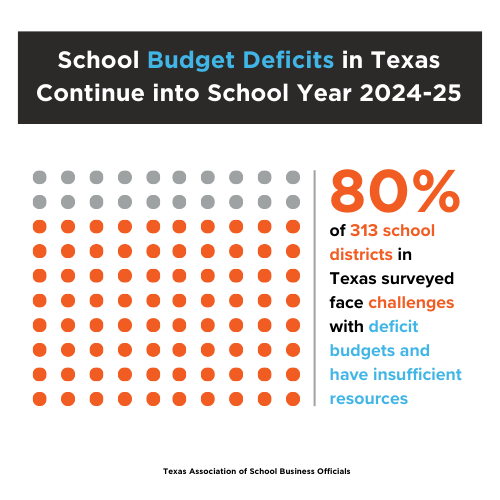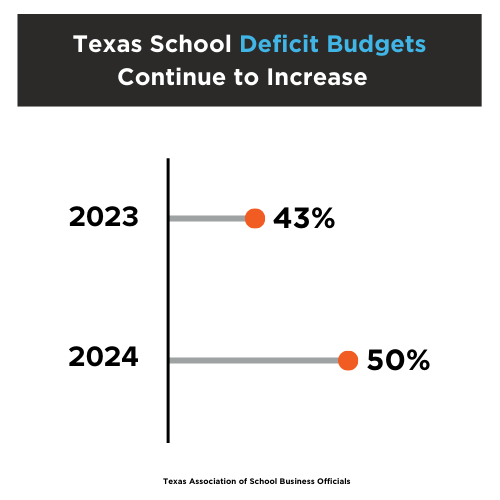
categories
Why Texas School Districts are Filing Deficit Budgets

August 07, 2024

As the 2024-25 school year approaches, Texas school districts are bracing for significant financial challenges. Superintendents and school boards across the state face the daunting task of creating school budgets amid historic inflation, the end of COVID-19 federal funding, and a lack of additional state funding since 2019. Many school districts across the state are adopting deficit budgets and cutting programs, while Texas has $21.2 billion available.
Why There is a School Funding Crisis in Texas
The main reason for Texas’ school funding crisis is the Legislature’s failure to increase the basic allotment during the 88th Session. The basic allotment is the foundational funding block for student funding in Texas, and currently, schools need an additional $1,300 per student just to maintain the purchasing power they had six years ago.
Our current school funding system doesn’t account for inflation, and since 2019, inflation has surged over 22%. School districts, like the average household, are struggling to make ends meet. Rising fuel prices, property insurance, maintenance costs, health insurance, and food service costs are some of the biggest drivers of the budget strain on schools.
The rising costs and lack of adequate funding for school safety requirements, and accelerated instruction mandates outlined in HB 4545 all add to schools’ growing costs.
Further stressing Texas public schools is the expiration of federal ESSER (Elementary and Secondary School Emergency Relief) funds, which were critical in helping schools navigate the challenges of the pandemic. Without these funds, schools are scrambling to meet their students’ academic needs. Unfunded and underfunded state mandates passed during the pandemic without adequate state support add to the funding woes.

TASBO’s (Texas Association of School Business Officials) 2024 school finance survey gathered responses from 313 Texas school districts, reflecting 54% of the state’s students. The survey revealed that nearly 80% of respondents face challenges with deficit budgets or insufficient resources. While less than a third of schools reported deficit budgets for the fiscal year of 2023, over half anticipate deficits for the fiscal year of 2024.
The TASBO survey also indicates that more than 50% of the surveyed districts anticipate implementing budget cuts and using fund balances in the fiscal year of 2025. Currently, 43% of districts are undergoing significant cuts.

TASBO identified measures that school districts are considering to alleviate current financial constraints, including:
- staff reallocation;
- staff reductions through attrition;
- curtailing custodial and travel services;
- eliminating contract services;
- reducing department budgets;
- revising staffing formulas; and,
- trimming online services/software.
Additional Issues Impacting School Budgets
The expiration of ESSER funds, often referred to as the “COVID-19 funding cliff,” is also a significant factor in the current ISD budget deficits. During the pandemic, these funds addressed immediate needs such as remote learning technology, PPE, and enhanced cleaning protocols. However, these funds have now run out, and schools are struggling to find resources to continue the work.
Enrollment numbers also play a critical role in determining a school district’s budget. Funding formulas are largely based on student attendance, so a decline in enrollment directly translates to less funding. Each student, on average, across the state draws about $10,000 through the foundation school program. Bob Popinski, senior director of policy at Raise Your Hand Texas, explains if enrollment is lower than expected, then a school receives less funding. If there are 10 kids transferring out of a district, and it is a small school district, then that’s $100,000 the school district does not receive in funding from the state. If, for example, 10 kids transferred out, a Texas public school would lose funding equivalent to 2 teacher salaries and potentially need to close 2 classrooms to accommodate.

When students leave a district to attend a charter school, become homeschooled, or attend a private school, or even if early childhood students in pre-K or kindergarten miss school, it causes significant strain on school districts. Additionally, school districts still need teachers and paraprofessionals in every classroom, bus drivers to drive the buses, food service workers—and many more people—to keep a school running well.
The Impact of School District Budget Deficits
Texas school districts are making difficult budget decisions right now, including whether to cut extracurricular programs, lay off staff, or -in some cases- close schools. These decisions can have a long-term impact on educational quality and career outcomes.
Montgomery Independent School District (MISD) exemplifies the financial challenges many Texas districts face. Superintendent Dr. Mark Ruffin recently shared on X that MISD will head into the 2024-25 school year facing a $4.3 million deficit despite adopting a $93 million budget. This deficit comes on top of sending over $3 million back to the state in 2023 due to recapture payments. “Amidst this budget deficit, we have remained committed to protecting the people, programs, and services that make up the premier educational experience for our students. But at some point, something has to give,” Dr. Ruffin said.
MISD, like many other districts, has been negatively impacted by factors outside its control, such as inflation, decreases in federal funding through Medicaid reimbursements, stagnant state funding, and mandatory recapture payments. The Medicaid crisis, particularly the reduction in reimbursements through the School Health and Related Services (SHARS) program, is a significant concern. SHARS provides critical funding for health-related services for students with disabilities, and the decrease in reimbursements means that schools are not being adequately compensated for these essential services. This adds to the financial strain on districts, which must cover these costs without sufficient support.
The 89th Texas Legislature Should Effectively Address School Funding
Ensuring sustainable, long-term funding solutions is essential for the stability and success of Texas schools. The future of our 5.5 million public school students and the vitality of our communities depend on it.
Without adequate funding for our public schools, the Texas legislature risks the quality of education and the future of Texas students. It’s time to prioritize public education and ensure every child has access to the resources they need to succeed.
Stay informed and engaged in what is happening across the state by subscribing to our Across the Lawn newsletter. If you are ready to advocate for increased public school funding, contact your Raise Your Hand Texas Regional Advocacy Director. You can also contact your legislator or participate in local school board meetings to create a strong, unified voice that can influence policymakers to prioritize education in the Texas state budget.

###



